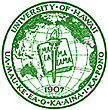
UH panel
rejects all
designs for logo
The university will retain
the school seal after proposals
are criticized as "generic"
Two years and more than $142,000 later, the University of Hawaii's search for a systemwide logo has ended with a decision to scrap the project and return to the UH official seal.
The committee found the logos were "generic" and "not artistically distinguished at all," said Chairman Francis Oda, chief executive of Group 70 International. "Personally, I feel somewhat disappointed that we couldn't come up with something we could work with."
Instead of creating another search process for new logo designs, acting UH President David McClain said UH will keep the school's original seal and modify the font or typeface to make it unique to each campus.
"At this point we'll need to put the logo on a back burner and move forward," said McClain. "There may be a point sometime in the future down the road we may have another process."
The UH seal has a globe with a torch and book in the middle outlined with "University of Hawaii" and the state's motto.
The university spent $142,637 in its search for a new logo.
"It's a lot of money wasted," said student Jame Schaedel, political science senior.
Each of the 13 committee members present -- two were absent -- scored each design out of 100 points.
The scoring was based on the message conveyed and the quality of the design, including visual impact and its use in applications.
Posters of the designs showed the logos used in different media, including on the UH Web site, T-shirts, vans, stationery and business cards.
To move forward in the selection process, a design had to receive at least 85 percent of the possible points by the committee.
No design even met 50 percent of the possible points, said Oda. But he called the three firms that designed the logos the "cream of the crop" of Hawaii.
"It just shows how difficult it is to come up with the right mark," he said.
In April 2003, UH President Evan Dobelle rejected the "wave" and "spectrum" designs by Maryland's Robert Rytter & Associates because of public outcry.
The six new proposed logos also received much public criticism, with 49 percent of the 660 comments received last week saying they picked "none of the above." That played a role in the committee's decision, Oda said.
"These (comments) inevitably influenced the individual's decision, but we were looking at the individual to come up with their own," he said.
Students and faculty members said they were relieved to hear of the committee's decision.
"It's great," said Tom Carpenter, speech lecturer, who said he did not like any of the logos. "Return to the rainbow."
"It's better to have a logo people like instead of being forced to use one," sophomore Stacey Baba said.
Elsa Carl, vice president at Clarence Lee Design & Associates, was disappointed in the decision.
"It's a shame," she said. "So much effort was spent now on the logo, and there's no solution. They have to learn that they can't please everyone. You have to take a stand, and once you do, people will get use to the idea and accept it."
The designers, Saedene Yee-Ota of Sae Design in Maui, Momi Cazimero of Graphic House in Honolulu and Clarence Lee, were unavailable for comment yesterday.
The logo search came out of the university's 2002 strategic plan and was intended to present a unified image for the system after officials found that there were more than 150 logos used systemwide.
www.hawaii.edu
